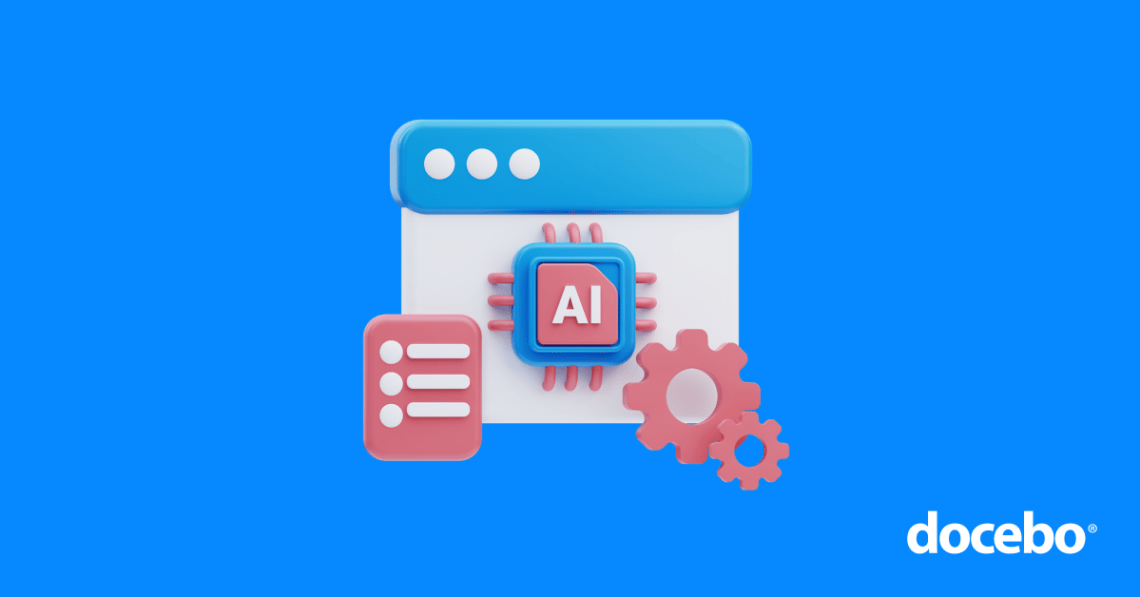
It’s almost time for a new calendar! In between holiday plans and figuring out New Year’s resolutions, we’re looking ahead to what 2024 will bring to L&D. What new challenges and opportunities are coming? And how much of the AI buzz is hype vs. reality?
To answer these questions, we took a little peek into a crystal ball…in the form of Docebo’s latest webinar, The Future of L&D Is Here – What Does It Look Like? In partnership with Speexx, whose all-in-one digital coaching platform combines cutting edge AI tech with world-class expertise, our L&D experts made four predictions about the L&D industry in 2024 (and beyond).
You can watch the full recording of this webinar here. Now let’s dive into the predictions!
Disclaimer: The information below is accurate as of March 5, 2024.
Prediction #1: The concerns about AI and automation will diminish as the benefits become undeniable
It’s tempting to think of the current buzz around AI as just another hype cycle—but there’s nothing here that says “fad”. Consider that the global market for AI in 2023 is worth over $136 billion. What’s more, it will grow by more than 13x to reach 1.8 trillion by the end of the decade!
Of course, such rapid growth comes with questions, skepticism, and uncertainty. Will this work? How will it affect my job? Consider that we’re still in the beginning stage of AI adoption, and AI is ultimately just a tool. With any new tool, we will get more comfortable with using it the more we understand it.
Automation has a slightly longer history and its impact will expand under AI’s influence. Some trends we’re already seeing include:
- Adaptive learning platforms: Automation can be used to create adaptive learning platforms that personalize learning experiences based on individual progress, preferences, and performance.
- AI-driven content creation: Learning content can be created from text prompts or from pre-existing materials (like documents and slide decks).
- Chatbots for learner support: Chatbots and virtual assistants can provide instant support to learners, answering questions, offering guidance, and facilitating discussions.
- Automated assessments and feedback: Automation can streamline the assessment process by utilizing AI for grading and providing feedback.
- Learning analytics: Automation will play a crucial role in learning analytics, providing insights into learner behavior, preferences, and performance.
Of course, striking the right balance between AI, automation, and human involvement will be crucial. And challenges like ensuring the ethical use of data and addressing concerns about job displacement need to be taken seriously.
The point here? It can take time to see the initial benefits of new technology. Once we do though, progress happens quickly.
Prediction #2: Hyperpersonalization will be the ‘next big thing’
“Personalization helps people meet their own agenda. They’re investing in themselves and building in themselves, making them more valuable for the future.”
– Donald H. Taylor, Chair at the Learning Technologies Conference
At this point, there’s simply no excuse for not offering personalization in your learning platform. Just consider these stats:
- The majority of consumers (59%) expect their data to be used to personalize their customer experiences.
- Meanwhile, 56% of consumers say they will become repeat buyers after a personalized experience: 7% more than last year!
It’s no surprise that personalization boosts engagement and retention. When your learners feel understood and valued, they’re more likely to sign in and stick around! Especially when today’s online experience is a constant bombardment of demands for our attention, making us feel digital fatigue.
It can make a huge difference to find content that speaks to your interests, instead of a cookie-cutter catch-all. As Fernando says, “If I don’t feel like I’m at home when I log into my LMS and I don’t see my experience has been personalized, then I’m going to disconnect from the very beginning.”
You should be doing as much as you can to ensure that learners are getting all the benefits of personalized experiences. Thankfully, with the power of AI, it’s easier than ever before to make these experiences possible. Recommending courses, tagging skills, tailoring content for each learner, and more. AI automates and streamlines these time consuming actions at a level we could only dream of doing before. In fact, there’s a word for that: Hyperpersonalization!
In short, to think of personalization as an add-on or special feature really undersells its value to your learning program. Personalization is not the icing on a cake; it’s a necessary layer of the L&D experience, now and throughout the future. (Need help unlocking the potential of personalization? Read our FAQ on using AI in your Docebo platform or check out our comprehensive AI Buyer’s Guide.)
Prediction #3: Previously-hidden L&D opportunities will emerge
Pop quiz! What’s the most common use of AI in L&D right now? Scroll down for the answer!
- Virtual coaching
- Content creation
- Auto-tagging
- Deep search

Time to test your L&D knowledge!
Time! If you answered “2. Content creation”, you’re absolutely on the mark! As Donald H. Taylor, Chair at the Learning Technologies Conference, notes, “People who are using AI in L&D right now are using it, first and foremost, to create content faster.”
Indeed, with AI, the time it takes to create content has gone from being measured in days and weeks to hours and even less. To illustrate one example, you can create learning content in Docebo Shape in a manner of minutes, thanks to the wizardry of AI.
L&D teams will have the opportunity to reclaim a significant amount of bandwidth and will need to think strategically about how best to use it.
How about adding another dimension to the reporting and evaluation of your learning program’s success? Fernando suggests backing up any qualitative analysis of L&D performance with quantitative data. “Instead of talking about L&D in a very ethereal way, show the great things [your learning program] has done with data to back it up,” says Fernando. “Show that L&D is a key element to what the organization needs.”
This data may take the form of comparing the performance of learners that have completed a training module with similar employees who haven’t. As long as you can connect that data to the company’s KPIs, you will always have something to underscore your learning program’s impact.
Here’s one example: After finishing internal training on product knowledge, the sales team is closing more deals than ever. That’s a connection!
Prediction #4: L&D professionals become more AI-focused
By now, you’ve likely noticed that these predictions logically follow from one to the next:
- As we become more comfortable with AI, we’re more likely to see and utilize its benefits, such as hyperpersonalization and quicker content creation.
- Taking advantage of these benefits will give more room for L&D growth, such as leveraging data to demonstrate L&D impact.
So, what’s the next deduction to make? If one of the opportunities to grow L&D means utilizing data more effectively, it stands to reason that successful L&D professionals will be more likely to wielding AI tools while effectively analyzing and summarizing data.
Because they are focused on demonstrating impact, these L&D professionals also count interpersonal, intra-organizational communication within their skillset. It can show up in many ways, like connecting to key departments and roles, creating steering groups, and transforming into a successful L&D marketer. (Or, as the kids say these days: An influencer!)

L&D professionals are becoming superstar marketers for learning success. Selfies optional.
Worried that such a skillset isn’t your forte? Don’t be! While things are changing very quickly, it’s the nature of L&D to embrace change. Just remember why you engaged with L&D in the first place: “In a world where technology can do a lot, it’s the people that will make the difference,” says Donald. “We’re the people who help the people make a difference.”
Define the future
L&D practitioners who want to be at the top of their game in 2024 should remember these four predictions:
- AI and automation aren’t going anywhere, and people are becoming more comfortable with having them around. Expect this trend to continue.
- Personalization is table stakes, so use AI to bring it to the next level: Hyperpersonalization!
- Take advantage of the opportunities afforded by new AI tools. How about leveraging the data from your L&D program, connecting to KPIs, and demonstrating L&D’s impact on your business?
- The successful L&D professional in 2024 will understand the ins-and-outs of AI.
Hear the full stories
Want more examples and details to these success stories? Just watch the full webinar, Unlocking the Secrets of Learner Engagement: A Deep Dive into 3 Success Stories.
